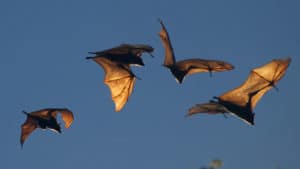Pop quiz: Which animal accounts for around 20% of all living mammals, harbors (yet survives) some of the world’s deadliest diseases, lives proportionately longer than humans given its body size, and helps make tequila possible?
Answer: Bats.
From the tiniest bumblebee bat (Craseonycteris thonglongyai) to the large (1kg) golden-capped fruitbat (Acerodon jubatus), the diversity and rare adaptations in bats have both fascinated and terrified people for centuries. Now, an international consortium of bat biologists, computational scientists, conservation organizations, and genome technologists has set out to decode the genomes of all 1,300 species of bats using SMRT Sequencing and other technologies.
The aim of the Bat1K initiative, as set forth by Emma Teeling of the University of Dublin, Sonja Vernes of the Max Planck Institute, and 146 others in this paper in the Annual Review of Animal Biosciences, is to “catalog the unique genetic diversity present in all living bats to better understand the molecular basis of their unique adaptations; uncover their evolutionary history; link genotype with phenotype; and ultimately better understand, promote, and conserve bats.”
The large sequencing project will be accomplished in three phases, starting with 21 representatives of each bat family, followed by 220 representatives for every genus of bat, and then the remaining 1,288 of the species. It will greatly expand upon the 14 bat genome assemblies currently available from the National Center for Biotechnology Information (NCBI) database, which are of varying quality and completeness.
“One primary goal of Bat1K is to standardize assembly strategies to provide assemblies of uniform optimal quality for the bat genomics community through combining multiple sequencing and scaffolding technologies,” the authors write. “We believe it is important not just to generate genome-level data, but to produce high-quality genome sequences that maximize the usefulness and accessibility of the data for all research fields.”
The bat clade exhibits a wide range of chromosomal variation. High-quality, chromosome-level genome assemblies across the group will allow researchers to investigate things like evolutionary trajectories of autosomal and sex chromosomes from nucleotide, syntenic, and phylogenomic perspectives.
The team is also hoping to resolve “some of the most passionate debates in science” centered around the evolutionary history of bats, which has been difficult to piece together due to an impoverished fossil record.
Helping Humanity
 The information they uncover could benefit not only the research community, but the world at large. The authors argue that studying bats will enable us to address some of the most important challenges facing humanity into the next century including improving the well-being of a large and rapidly aging human population, preventing the spread of emergent infectious diseases, maintaining agricultural productivity, and restoring natural ecosystems worldwide.
The information they uncover could benefit not only the research community, but the world at large. The authors argue that studying bats will enable us to address some of the most important challenges facing humanity into the next century including improving the well-being of a large and rapidly aging human population, preventing the spread of emergent infectious diseases, maintaining agricultural productivity, and restoring natural ecosystems worldwide.
Bats are suspected reservoirs for some of the deadliest viral diseases, including Ebola, SARS (severe acute respiratory syndrome), rabies, and MERS (Middle East respiratory syndrome coronavirus). But they appear to be asymptomatic and survive these infections. Figuring out why could increase our understanding of immune function and help prevent viral spillovers into humans.
Bats also exhibit extraordinary longevity—they can live up to 10 times longer than expected given their small body size and high metabolic rate. Only 19 mammal species are known to live proportionately longer than humans given their body size, and 18 of these are bats.
“Bats show few signs of senescence and low to negligible rates of cancer, suggesting they have also evolved unique mechanisms to extend their health spans, rendering them excellent models to study extended mammalian longevity and ageing,” the team writes.
By identifying bats’ cellular repair mechanisms, researchers could also gain insight into inflammatory disorders associated with autoimmune diseases, which are among the fastest growing causes of disease worldwide.
“The ability to modulate inappropriate inflammation in response to stressors without impairing immune function could improve the lives of millions,” the authors write.
Studying the genetics of echolocation, vocal learning, and sensory perception in bats could shed light into human blindness, deafness, and speech disorders, they add. And characterizing bat wing development could improve our understanding of how changes in limb developmental building blocks can lead to human limb malformations.
In regard to the ecosystem, bats perform key services. They pollinate crop species in the tropics (including agave, making possible the distillation of tequila) and disperse seeds across long distances, maintaining plant genetic diversity and aiding the regeneration of forests after clearing. They are able to breach ocean barriers, making them indispensable to isolated island ecosystems. They also feed on crop pests throughout their range; without bats, it is estimated that the United States would spend more than $3 billion a year on pesticides alone, the authors report.
“Bat1K will develop a genomic ark that can be used to benchmark the genomic health of different bat species to uncover populations in need of immediate conservation efforts,” the authors write. “Prioritization of bat genomes is not just desirable but indispensable to confront the many challenges to human well-being, ecosystem function, and biodiversity conservation we now face.”
Catch one of the Bat1K project leaders, Sonja Vernes, as a keynote speaker at the 2018 SMRT Leiden Conference, to be held in the Netherlands June 12-14. The meeting includes two back-to-back events: SMRT Scientific Symposium and the SMRT Informatics Developers Meeting. View the preliminary agenda and register
April 17, 2018 | Plant + animal biology